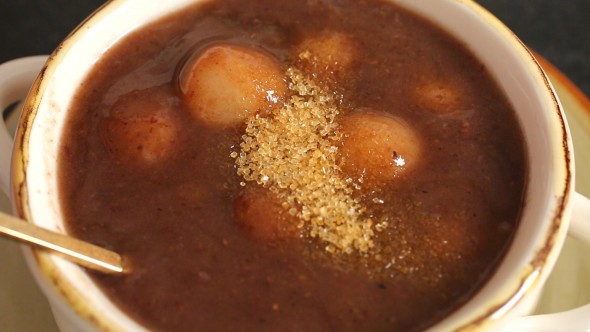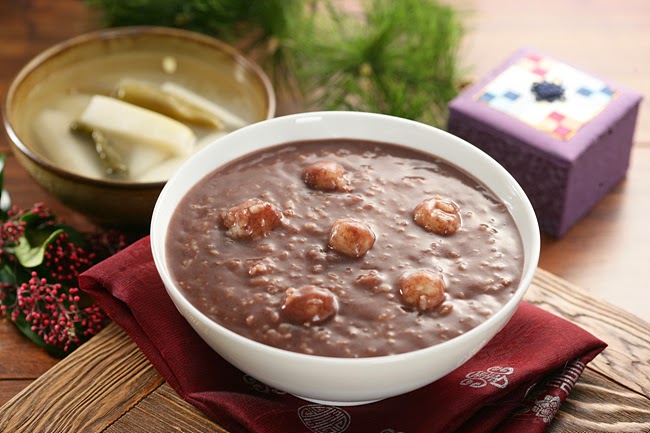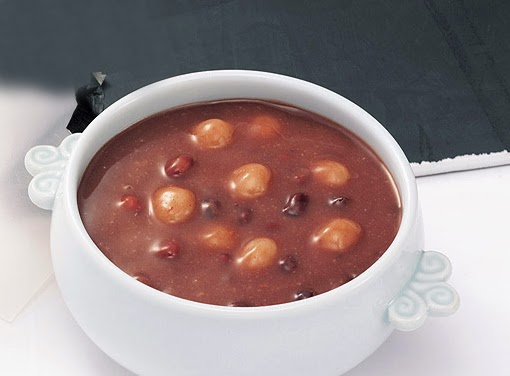Patjuk: the Must-Have Korean Food for Winter

Like the other seasons, the winter season is full of its own traditions. There are always clothes you wear, activities you do, and food you eat during winter that you probably don’t do in other seasons. Like many other things, each country holds their own traditions for the winter season. In South Korea, there are many foods that one would consider a “winter” food. In this article, I’ll be talking about one food in particular that has a strong tie with the winter season: Patjuk.
If you’d like to read into a few other Korean Winter Foods, you can check out this article on our blog!
Table of Contents
What is Patjuk?
For a simple description, Patjuk is red bean porridge with rice cakes/dumplings. It’s served warm and usually as its own meal—not a dessert or snack. This meal in particular is served in the winter time during Dongji (or, the Winter Solstice). Though there may be various garnishes, this dish usually comes in a bowl by itself.
What are the ingredients?
Compared to some other Korean meals, Patjuk includes only a few ingredients. Also compared to other meals, the ingredients within this dish are simple and easy to find.
For a basic Patjuk recipe, there will be four main ingredients:
- Red beans
- Water
- Rice
- Salt
However, since this meal is rather simple, it can come in a few variations. And, with the variations to the meal, the ingredients list gets longer.
For the variations, you can have Dan-Patjuk—a sweetened porridge made of the same ingredients, but with added sugar or honey to make it sweeter. Another variation is the Patkalguksu—a red bean noodle dish that uses noodles instead of rice.
This meal is also rather popular because its ingredients are vegetarian/vegan friendly.
What is the history of Patjuk?
As I mentioned before Patjuk is a dish closely tied to the winter solstice (dongji). Winter solstice takes place every year either on December 21st or December 22nd. This makes it the heart of winter, meaning the perfect time for a warm meal.
However, the reason Patjuk is such a traditional dish for the winter solstice in Korea is because of the folklore tied with it. Though there hasn’t been a specific tale labeled as the cause, there are a few guesses as to which tale this dish is closely tied with.
As we know, winter solstice is the day with the shortest daylight and the longest night in a year. This means that there is more darkness during this day than any other day of the year. And, as is with many folklore, darkness is usually symbolic for negative things (negative being illnesses, bad luck, or evil spirits).
If we were to look at the one folklore people tie to the history of Patjuk, you will see this theme prevalent. This folklore, an old Chinese folklore, is about a man’s son who dies on winter solstice and becomes a disease-spreading evil spirit. However, according to the story, the son was afraid of red bean porridge. As a result, people started to make Patjuk on winter solstice to ward of the evil spirit.
Furthermore, there’s a belief that the color red is symbolic of positive energy. Meaning that this red-colored meal will ward off any bad luck, diseases, and influences of evil spirits that might come your way.
Another Reason for Patjuk’s History
If you’re a bit skeptical about Patjuk being tied to a folklore, then there’s another reason that Patjuk became such a staple during the winter season. In the history of Korea, they were always heavily agricultural—meaning that they relied heavily on having rich harvests.
During winter months, since it was too cold to provide harvests, they would make Patjuk with fewer resources than other meals. Since Patjuk contained so few ingredients, it wasn’t hard to do. Though they did not put a lot of rice in because of the rationing of rice throughout the winter season.
Along with this, the dish became a ritual to wish for abundant harvests in the upcoming farming season.
How do you make Patjuk?
Along with the simple ingredients, it’s actually rather easy to make Patjuk. The only issue is that it’s a bit time-consuming.
The first steps include boiling the water and red beans. After that, you drain the water, add salt to the beans, and then mash them. Yes, mash them. With the use of a strainer, you can mash the juice from the beans into a bowl.
From here, you add water to the mashed bean liquid and boil again. Somewhere after here, you add the rice. And, of course, you add red beans again (not mashed this time) to the mix.
It’s a bit hard to explain, so you can check out this recipe. You can also watch this video to help with the cooking process. I know it sounds a bit confusing now, but it’ll make much more sense after watching the video and reading the recipe.
If, after all this talk about food, you want to glance at a few other articles we’ve written about Korean food, feel free to check out our Food Category. And if you want to check out Korean foods specifically for the winter season, you can visit the article I mentioned at the beginning here or watch the short video below.
There are plenty of wonderful Korean foods that you can try out, so don’t worry about not finding one right away to fit your taste buds. Give a glance at our articles and give each food a chance before you push them aside. Perhaps Patjuk will truly bring you the positive energy you need to get through this winter.













